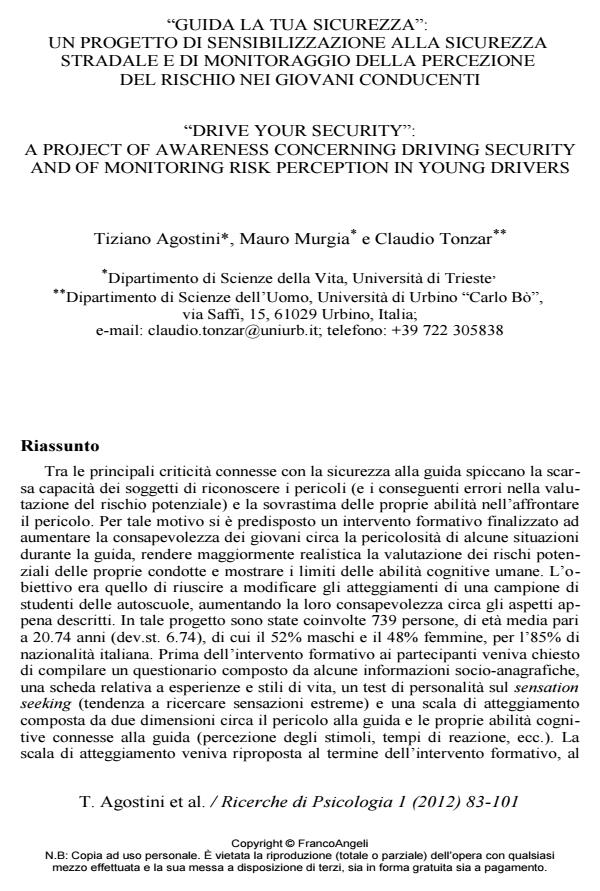"Drive your security": a project of awareness concerning driving security and of monitoring risk perception in young drivers
Journal title RICERCHE DI PSICOLOGIA
Author/s Tiziano Agostini, Mauro Murgia, Claudio Tonzar
Publishing Year 2013 Issue 2012/1
Language Italian Pages 19 P. 84-101 File size 674 KB
DOI 10.3280/RIP2012-001005
DOI is like a bar code for intellectual property: to have more infomation
click here
Below, you can see the article first page
If you want to buy this article in PDF format, you can do it, following the instructions to buy download credits

FrancoAngeli is member of Publishers International Linking Association, Inc (PILA), a not-for-profit association which run the CrossRef service enabling links to and from online scholarly content.
Lacking abilities in recognizing dangers (and consequent errors in the evaluation of potential risks) and overestimation of one’s own abilities in coping with dangers are two of the main issues associated with security in driving. For this reason we developed an educational intervention aimed at: 1) increasing the awareness of youths about the dangerousness of certain situations in driving; 2) making the evaluation of potential risks of their behaviors more realistic; 3) showing them the limits of human cognition. The aim was modifying the attitudes of a sample of driving school students, by increasing their awareness about the above mentioned topics. 739 people were involved in this project: their average age was 20.74 years (S.D. 6.74). The 52% were males and the 48% females, the 85% were Italians. Before the educational intervention, participants were asked to fill a questionnaire which included socio-demographic information, experiences and life styles information, a personality test about the sensation seeking, and an attitude scale. This last scale was composed by two subscales regarding the danger in driving and the one’s own cognitive abilities associated with driving (stimuli perception, reaction times, etc.). The attitude scale was administered again after the educational intervention, in order to compare the values obtained before and after the intervention and, consequently, evaluate its efficacy. Results showed a statistically significant change in participants’ attitude. In particular, the perception of danger associated with some "at-risk" behaviors increased after the intervention. At the same time, the perception of cognitive efficiency and efficacy decreased, and participant achieved a major awareness of their own motor-perceptual limits related to driving skills.
Keywords: Traffic psychology, risk perception, perception and action, driving.
Tiziano Agostini, Mauro Murgia, Claudio Tonzar, "Guida la tua sicurezza": un progetto di sensibilizzazione alla sicurezza stradale e di monitoraggio della percezione del rischio nei giovani conducenti in "RICERCHE DI PSICOLOGIA " 1/2012, pp 84-101, DOI: 10.3280/RIP2012-001005